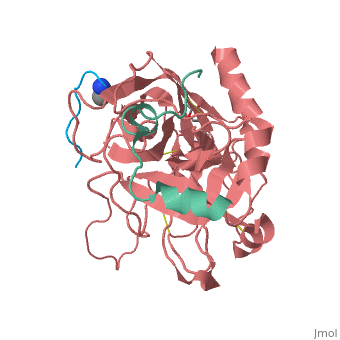3vxe
From Proteopedia
Human alpha-thrombin-Bivalirudin complex at PD5.0
Structural highlights
DiseaseTHRB_HUMAN Defects in F2 are the cause of factor II deficiency (FA2D) [MIM:613679. It is a very rare blood coagulation disorder characterized by mucocutaneous bleeding symptoms. The severity of the bleeding manifestations correlates with blood factor II levels.[1] [2] [3] [4] [5] [6] [7] [8] [9] [10] [11] [12] Genetic variations in F2 may be a cause of susceptibility to ischemic stroke (ISCHSTR) [MIM:601367; also known as cerebrovascular accident or cerebral infarction. A stroke is an acute neurologic event leading to death of neural tissue of the brain and resulting in loss of motor, sensory and/or cognitive function. Ischemic strokes, resulting from vascular occlusion, is considered to be a highly complex disease consisting of a group of heterogeneous disorders with multiple genetic and environmental risk factors.[13] Defects in F2 are the cause of thrombophilia due to thrombin defect (THPH1) [MIM:188050. It is a multifactorial disorder of hemostasis characterized by abnormal platelet aggregation in response to various agents and recurrent thrombi formation. Note=A common genetic variation in the 3-prime untranslated region of the prothrombin gene is associated with elevated plasma prothrombin levels and an increased risk of venous thrombosis. Defects in F2 are associated with susceptibility to pregnancy loss, recurrent, type 2 (RPRGL2) [MIM:614390. A common complication of pregnancy, resulting in spontaneous abortion before the fetus has reached viability. The term includes all miscarriages from the time of conception until 24 weeks of gestation. Recurrent pregnancy loss is defined as 3 or more consecutive spontaneous abortions.[14] FunctionTHRB_HUMAN Thrombin, which cleaves bonds after Arg and Lys, converts fibrinogen to fibrin and activates factors V, VII, VIII, XIII, and, in complex with thrombomodulin, protein C. Functions in blood homeostasis, inflammation and wound healing.[15] Publication Abstract from PubMedThe protonation states and hydration structures of the alpha-thrombin-bivalirudin complex were studied by joint XN refinement of the single crystal X-ray and neutron diffraction data at resolutions of 1.6 and 2.8A, respectively. The atomic distances were estimated by carrying out X-ray crystallographic analysis at 1.25A resolution. The complex represents a model of the enzyme-product (EP) complex of alpha-thrombin. The neutron scattering length maps around the active site suggest that the side chain of H57/H was deuterated. The joint XN refinement showed that occupancies for Ddelta1 and Depsilon2 of H57/H were 1.0 and 0.7, respectively. However, no significant neutron scattering length density was observed around the hydroxyl oxygen Ogamma of S195/H, which was close to the carboxylic carbon atom of dFPR-COOH. These observations suggest that the Ogamma atom of S195/H is deprotonated and maintains its nucleophilicity in the EP complex. In addition to the active site, the hydration structures of the S1 subsite and the Exosite I, which are involved in the recognition of bivalirudin, are presented. Neutron and X-ray crystallographic analysis of the human alpha-thrombin-bivalirudin complex at pD 5.0: protonation states and hydration structure of the enzyme-product complex.,Yamada T, Kurihara K, Ohnishi Y, Tamada T, Tomoyori K, Masumi K, Tanaka I, Kuroki R, Niimura N Biochim Biophys Acta. 2013 Aug;1834(8):1532-8. doi: 10.1016/j.bbapap.2013.05.014., Epub 2013 May 25. PMID:23712263[16] From MEDLINE®/PubMed®, a database of the U.S. National Library of Medicine. See AlsoReferences
| ||||||||||||||||||||
Categories: Hirudo medicinalis | Homo sapiens | Large Structures | Kurihara K | Kuroki R | Masumi K | Niimura N | Ohnishi Y | Tamada T | Tanaka I | Tomoyori K | Yamada T

